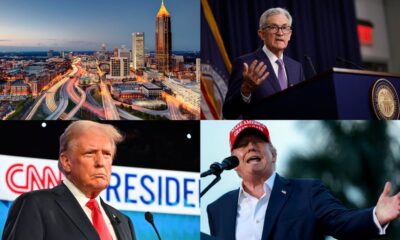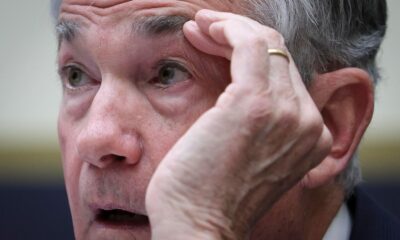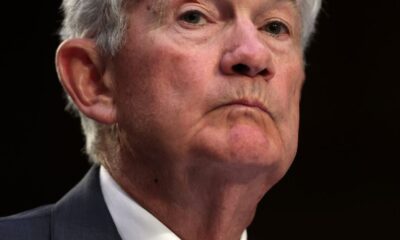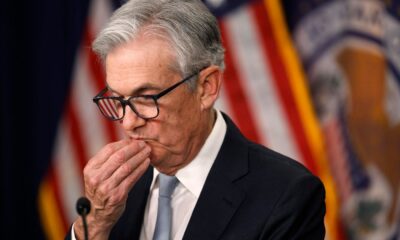Bitcoin
Como o Fed impacta ações, criptografia e outros investimentos
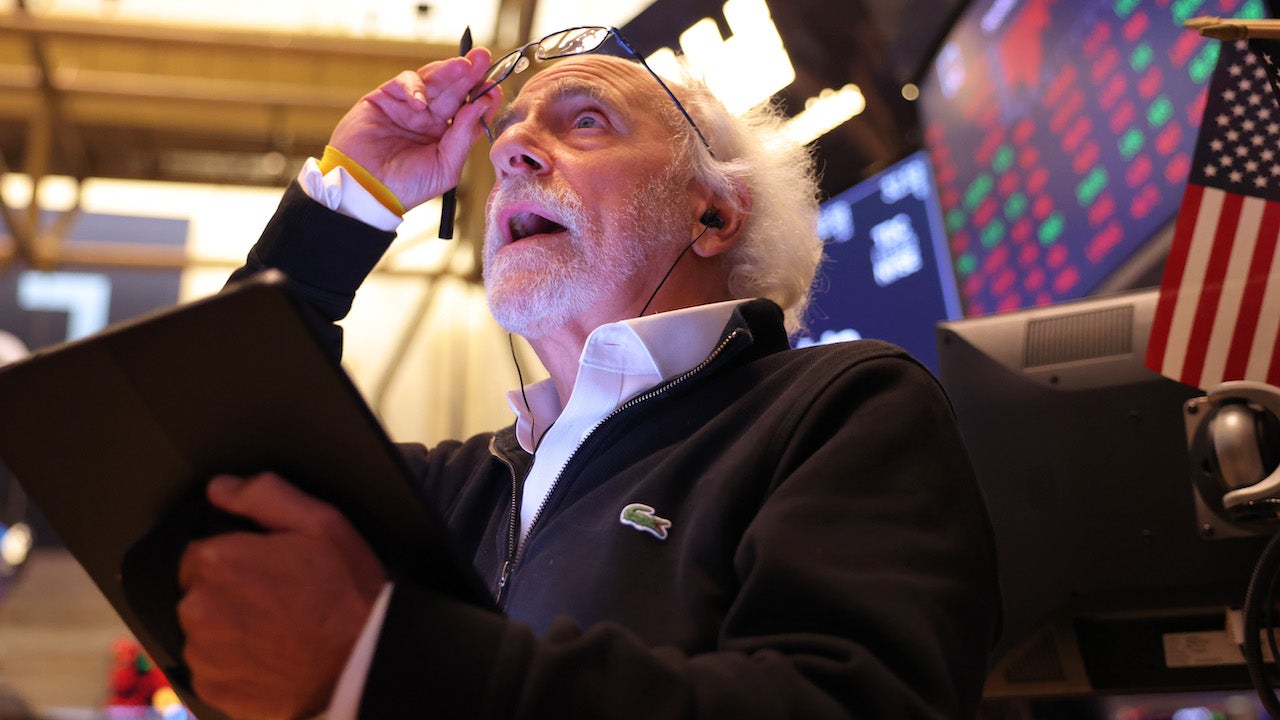
Taxas mais altas têm ocorrido em ações, criptomoeda e mercadorias como o petróleo nos últimos dois anos e mais. Mas o que os investidores podem esperar daqui e por quanto tempo o ambiente de taxas impactará os mercados?
Durante mais de dois anos, a perspectiva de taxas de juro mais elevadas tem afectado os mercados, mas a direcção das taxas atingiu um ponto de viragem em meados de 2023. Em oito das suas últimas nove reuniões, incluindo a que terminou em 12 de Junho, a Reserva Federal optou por manter as taxas estáveis, depois de aumentar as taxas 11 vezes neste ciclo económico. Agora, poucos analistas duvidam que as taxas estejam prestes a descer, à medida que a inflação – que atingiu 3,3% em maio – está cada vez mais sob controle.
Taxas mais altas e temores de recessão perdendo efeito no mercado
Embora a Fed já tenha aumentado as taxas 11 vezes durante este ciclo de aperto, é fácil detectar quando os mercados realmente se acalmaram e perceberam que o banco central não estava a brincar ao dizer que estava prestes a recalibrar a política monetária. Era novembro de 2021 quando a criptomoeda e muitas das ações mais arriscadas atingiram o pico.
“Quando o Fed introduziu políticas monetárias restritivas aumentando as taxas em 2022, isso fez com que os mercados de ações e as criptomoedas caíssem apropriadamente na avaliação”, diz Octavio Sandoval, diretor de investimentos da Illumen Capital.
“O mercado de ações nunca deixará de se preocupar com as taxas de juros futuras”, afirma Steve Azoury, chefe da Azoury Financial em Troy, Michigan. “O custo dos empréstimos afeta todas as áreas de investimento, compras e poupança. Apenas a antecipação do que pode acontecer é suficiente para provocar uma reação no mercado de ações.”
E a direcção das taxas parece estar a assustar menos os investidores hoje em dia, uma vez que estes antecipam que a trajectória futura das taxas de juro será mais baixa, embora ainda demore alguns meses.
Embora os principais índices de ações, como o Standard & Poor’s 500 passaram a maior parte de 2022 em pânico, eles se saíram bem em 2023 e agora estão perto de seu ponto mais alto em meados de 2024. O S&P 500 subiu cerca de 24% no ano passado, enquanto o Composto Nasdaq subiu cerca de 43 por cento. Eles também seguiram com um primeiro tempo forte.
Mas e a tão esperada recessão? A recente força relativa do mercado sugere que os investidores podem estar mais optimistas – ou pelo menos menos pessimistas – do que eram antes. Muitos analistas prevêem uma chamada “aterragem suave” para a economia, um cenário em que a inflação diminui e o desemprego aumenta um pouco, mas a economia não entra numa recessão total.
“O medo da recessão não parece ser uma preocupação dos mercados neste momento e penso que isso está a intrigar muitos”, afirma Brian Spinelli, co-diretor de investimentos do consultor de fortunas Halbert Hargrove em Long Beach, Califórnia.
Assim, depois de uma forte recuperação em 2023 e 2024, poderá ainda haver muito espaço para os mercados caírem ainda mais se o economia piora significativamente.
Muitas ações não lucrativas de alto crescimento tiveram um 2022 difícil e, embora os preços tenham se firmado em 2023, isso não significa que essas ações ainda estejam perto de seus máximos anteriores. Por exemplo, ações de software como Cloudflare, Zoom Video Communications e Confluent valem menos da metade de seus máximos históricos. No entanto, ações lucrativas de grandes nomes como Microsoft, Apple e outras em o Magnífico 7 teve um bom desempenho, apesar dos movimentos nas taxas.
Os preços das criptomoedas enfrentaram dificuldades à medida que as taxas de juros pareciam subir, mas agora que as taxas parecem preparadas para uma queda no curto prazo, os preços das criptomoedas aumentaram substancialmente. E a introdução de ETFs de Bitcoin ajudou a impulsionar o preço do Bitcoin, que atingiu um máximo histórico em março. A perspectiva de taxas mais baixas e potenciais influxos para ETFs empurrou Ethereum mais alto também.
As taxas de juros irão descarrilar as ações?
As ações e as criptomoedas sofreram uma volatilidade notável, à medida que os investidores levaram em conta o aumento das taxas. Mas o que nos espera para os próximos seis meses, com a Fed aparentemente a aumentar as taxas e possivelmente a reduzi-las este ano?
Com menos dinheiro circulando nos mercados financeiros devido às taxas mais altas, isso representa um saldo negativo para os investimentos como um todo. Ainda assim, investimentos como grandes ações de tecnologia estão a ter um bom desempenho em 2024, enquanto outras – nomeadamente ações de bancos regionais e de pequenas dimensões – continuam a ter um desempenho fraco, à medida que os investidores se preocupam com o aumento das taxas, a fuga de depósitos e os imóveis comerciais sobrevalorizados. Mas os investidores têm o hábito notável de olhar além das notícias de hoje.
Os observadores do mercado ainda estão divididos sobre se o Fed manterá as taxas muito altas por muito tempo e se isso já está precificado nas ações. Esta própria incerteza impulsiona a volatilidade nos mercados.
“Temo que esta abordagem de não cortar as taxas, ou o medo de cortar as taxas de juro demasiado cedo, possa empurrar a economia para uma recessão de curto prazo”, afirma Dan Raju, CEO da Tradier, uma plataforma de corretagem.
“Não sei como o mercado irá responder se os atuais cortes nas taxas de juros precificados para 2024 não se concretizarem e o Fed mantiver as taxas mais altas por mais tempo”, diz Spinelli. “A narrativa da aterrissagem suave parece ter se consolidado, mas continua a haver muitos participantes do mercado céticos de que isso realmente vá acontecer.”
Entretanto, os mercados continuam a reajustar-se ao ambiente económico com a expectativa de que as taxas estejam preparadas para descer, mas não tão cedo como anteriormente esperado.
O título de referência do Tesouro a 10 anos, que oferece agora um rendimento de 4,26 por cento, não está muito abaixo do seu máximo de 52 semanas, de 4,99 por cento, estabelecido em Outubro, após um aumento no início do ano.
Agora, com as taxas de curto prazo bem acima das taxas de longo prazo – a chamada inversão da curva de rendimentos – muitos observadores do mercado ainda esperam uma recessão que ocorrerá em 2024. Uma recessão provavelmente empurraria o mercado de ações ainda mais para baixo até que os investidores pudessem começar a avaliar a duração e a profundidade de qualquer recessão que se aproxima. Mas isso pode não impedir que as ações subam de forma intermitente.
Como as taxas de juros afetaram os mercados de criptomoedas e commodities
Duas outras grandes classes de activos tiveram respostas variadas face às taxas mais elevadas. Embora os preços das criptomoedas tenham despencado juntamente com outros ativos de risco, muitas matérias-primas dispararam no início de 2022, incluindo o petróleo, mas muitas dessas medidas revelaram-se de curta duração. Com o aumento da taxa de fundos do Fed desacelerando e depois parando em 2023, tanto o petróleo quanto a criptografia parecem ter encontrado algum apoio.
A criptomoeda tem sido frequentemente apontada como um cura para tudo o que te aflige, seja inflação, taxas de juros baixas, falta de poder de compra, desvalorização do dólar e assim por diante. Era fácil acreditar nesses aspectos positivos enquanto a criptografia aumentava, aparentemente independentemente de outros ativos.
“A verdade é que os preços das criptomoedas provaram ser impactados pelo mesmo sentimento direcional que afeta os investidores em ações de varejo”, diz Raju. “Em geral, as altas taxas de juros afastam os investidores de investimentos mais arriscados, como a criptografia, e a redução das taxas será vista como positiva pela comunidade de investidores em criptografia.”
Na verdade, as criptomoedas responderam à redução da liquidez, tal como outros ativos de risco, caindo quando a Fed anunciou, em novembro de 2021, a sua intenção de aumentar as taxas e depois ao longo de 2022, à medida que a Fed prosseguia agressivamente. Além disso, as explosões de criptomoedas e bolsas como a FTX prejudicaram a confiança dos traders nesses ativos virtuais.
Mas a instabilidade no sector bancário levou muitos comerciantes a licitar criptomoedas, na crença de que a trajetória futura de aumentos das taxas seria menos severa. E como as taxas do Tesouro a 10 anos atingiram o pico em Outubro de 2023 e depois caíram, os activos mais arriscados subiram, à medida que o caminho para taxas de juro mais baixas parece claro.
Mas outros fatores também estão em jogo no aumento da criptomoeda no ano passado.
“A antecipação da aprovação de ETFs Bitcoin à vista parece ser o principal motivador”, diz Spinelli.
No início de janeiro, a SEC aprovou 11 gestores de ativos para oferecer ETFs Bitcoin. A expectativa da aprovação ajudou a criptomoeda a terminar 2023 forte e, em seguida, os influxos para os novos ETFs impulsionaram a criptomoeda a um novo máximo histórico em março.
Quanto às matérias-primas, muitas têm estado bem longe dos máximos recentes, uma vez que menos restrições de oferta e taxas de juro mais elevadas contribuem para as reduzir alguns níveis. Mas a expectativa de que a Fed baixe em breve as taxas ajudou a evitar que o petróleo caísse substancialmente abaixo dos 70 dólares por barril em 2023 e 2024. Os preços também foram apoiados pelos países produtores de petróleo que anunciaram cortes na oferta e algum aperto geral no mercado.
Por exemplo, o preço do petróleo tinha estado numa tendência descendente constante para cerca de 70 dólares por barril, depois de ter atingido um pico de cerca de 123 dólares em Junho de 2022. E em 2023, o petróleo atingiu o fundo do poço em torno de 70 dólares e flutuou entre lá e 80 dólares durante grande parte de 2023, apesar de um período de meados do ano. subir para US$ 90. Depois de atingir cerca de US$ 70 por barril no início de dezembro de 2023, o petróleo apresentou tendência de alta no início do ano, mas recuou para menos de US$ 80 novamente no início de junho.
Como as taxas de juros devem impactar sua estratégia de investimento?
Taxas de juro, inflação e incerteza – tudo isto cria uma mistura de volatilidade para os investidores. Com tanta volatilidade, os investidores podem querer agir com cautela.
No entanto, a melhor maneira para a maioria dos investidores abordarem este tipo de mercado é seguir o plano de jogo de longo prazo. Para muitos, o plano de longo prazo significa continuar a investir regularmente num carteira diversificada de ações ou títulos e principalmente desconsiderando o barulho ao redor do mundo. Para outros, o plano de jogo pode envolver a compra e manutenção de ativos bem diversificados. fundos de índice. De qualquer forma, não deixe que as emoções atrapalhem um plano de investimento eficaz a longo prazo.
Embora os traders de curto prazo possam estar suando nas taxas e tentando cronometrar uma recessão, é vital manter as coisas em perspectiva. Em vez de tentar encontrar o momento certo para vender, investidores que compram e mantêm podem usar a volatilidade do mercado a seu favor e então tentar encontrar o momento certo para adicionar mais.
“Para investidores de longo prazo, os retrocessos representam oportunidades de compra atraentes”, diz Greg McBride, CFA, analista financeiro chefe do Bankrate.
As crises podem ser um momento atraente para adicionar ao seu portfólio a preços promocionais. Como lenda do investimento Warren Buffett disse uma vez: “Você paga um preço muito alto no mercado de ações por um consenso animador”. Ou seja, as ações ficam mais baratas quando poucos concordam que são um investimento atraente.
Resultado final
As taxas de juros subiram rapidamente em 2022 e 2023, e a grande questão agora é quanto tempo eles vão ficar lá. Os investidores com um horizonte de investimento de longo prazo podem encarar uma recessão como o momento ideal para adquirir alguns investimentos de qualidade a preços de pechincha.
E se as avaliações das ações despencam? Buffett também tem alguma sabedoria para essa situação: “As oportunidades surgem com pouca frequência. Quando chover ouro, coloque fora o balde, não o dedal.”
Isenção de responsabilidade editorial: Todos os investidores são aconselhados a realizar suas próprias pesquisas independentes sobre estratégias de investimento antes de tomarem uma decisão de investimento. Além disso, os investidores são informados de que o desempenho passado dos produtos de investimento não é garantia de valorização futura dos preços.
Bitcoin
Bitcoin Will Surge to $100K After Q4, Here’s Why
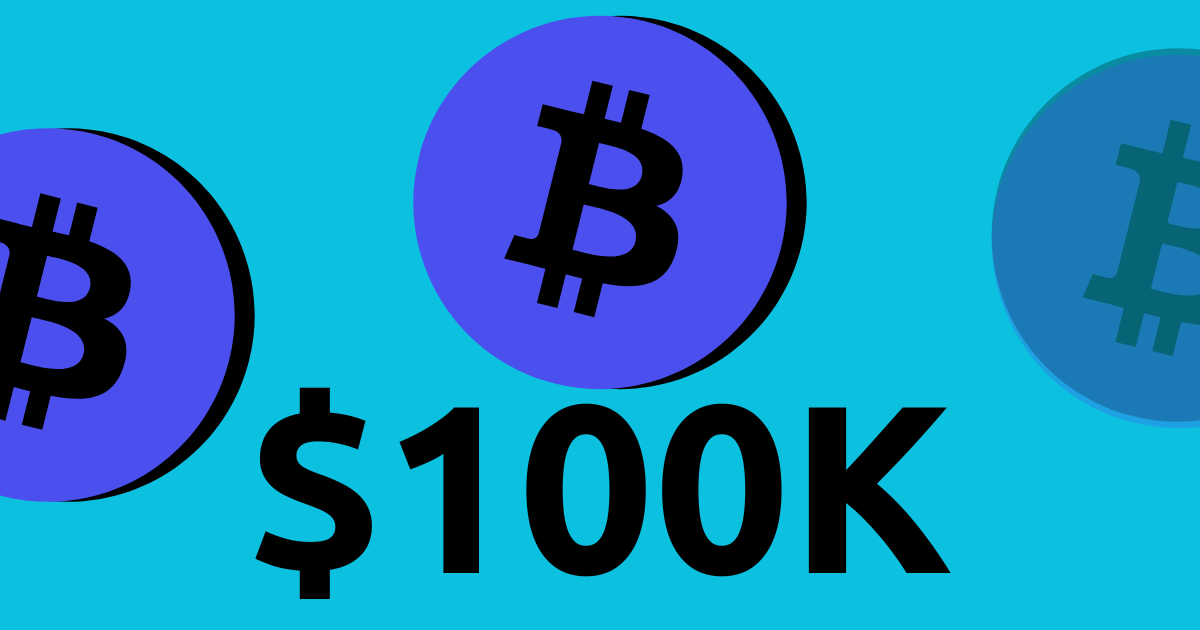
Dan Weiskopf, portfolio manager at Tidal Financial Group, spoke with David Lin and discussed the future prospects of Bitcoin. The focus was on the future of Bitcoin, especially its potential to reach $100,000. The talk also touched on recent market trends, noting strong interest in Bitcoin ETFs as a possible boost to its price. Looking ahead, there is hope that more platforms will approve Bitcoin ETFs, possibly pushing its price to $100,000.
Forecasts and Volatility: The Path to New Highs
While some predict Bitcoin could go as high as $150,000 or even $1 million, Dan agrees that it needs to hit $100,000 first. Dan also acknowledged Bitcoin’s volatility, saying that large price drops of as much as 50% to 70% could happen, drawing on his experience since 2017.
“We’re going to new highs because I think partly because ETF inflows have been really strong lately. Yeah, and then I think you’ll have more platforms approving spot Bitcoin ETFs in Q4, and we’re going to go up to 100K,” he said.
Big Investors and the Transformative Power of Bitcoin
He also discussed what is persuading large investors to get in on this cycle. He mentioned two key factors. Many argue that if you haven’t invested in Bitcoin, you’re missing out, citing its strong performance over the past decade. This pressure could influence returns and client expectations.
However, he emphasized a deeper reason: if you are not embracing the transformation driven by Bitcoin and digital assets, you may face challenges. This technology has the potential to reshape industries, just as the internet revolutionized business.
“A lot of people look at Bitcoin and crypto and don’t appreciate that with higher prices comes more supply. We talk about 100K, I would expect more supply to come into the market as we go up, and that’s not really new news, but it’s higher demand that’s offsetting that supply,” he added.
Read too: It’s time tor ETH Point ETF: Here’s What to Expect From the Ethereum Price Rally
Bitcoin
Bitcoin Jumps as Markets See Increased Chances of Trump Victory

CFOTO | Future Publishing | Getty Images
Bitcoin hit a two-week high on Monday as betting markets suggested a higher chance of crypto-friendly candidate Donald Trump winning the US presidential election.
The value of the world’s largest cryptocurrency, bitcoin, was up about 5% as of 1:40 p.m. London time to $62,781.48, according to CoinGecko.
The rally follow the dramatic and failed assassination attempt about the former president Trump on Saturday.
“There is a ‘parallel’ to the assassination of President Reagan in 1981,” even though it was not an election year, Ben Emons, chief investment officer at FedWatch Advisors, said in an emailed note.
“After the incident, Reagan’s popularity skyrocketed amid a double-dip recession. The S&P 500, however, fell 9% in the aftermath due to the economic malaise. But in the current strong economy, former President Trump’s favorability is likely to skyrocket and impact markets positively.”
Investors said on the weekend they were hoping that so-called “Trump victory trades” would get a boost. These trades broadened to include several cryptocurrency stocks, such as Coinbase Global and miner Riot platformswhich rose 4.5% and 5.25%, respectively, in pre-market trading.
“Bitcoin’s price rose about 9% over the weekend, which could indicate that investors are hoping that a Trump presidency will create a more favorable regulatory climate for the crypto industry,” Zach Pandl, head of research at Grayscale Investments, told CNBC in an email.
Trump has yet to lay out any detailed proposals on cryptocurrency regulation, but the Republican candidate is now seen as broadly supportive of the sector — despite his past skepticism. He is set to speak at a major annual bitcoin conference later this month.
Trump’s campaign started accepting donations of the cryptocurrency industry in May and its the message became increasingly positive about the future of these digital assets. He also sought to position oneself against Democrats who are in favor of controlling the industry, such as Senator Elizabeth Warren.
“In addition, macro policy changes under a second Trump presidency — including continued deficit spending, reduced U.S. leadership in international affairs, weaker Federal Reserve independence, and a desire for currency weakness to help reduce the trade deficit, among other things — could introduce downside risks to the U.S. dollar in the medium term. Any downside risks to the U.S. dollar could provide support for Bitcoin’s price,” Pandl added.
Last month, analysts at Standard Chartered said that the US presidential election is the next key catalyst for bitcoin’s price and a Trump victory could push it to $150,000 by the end of the year.
“Cryptocurrencies have not had an easy time in recent months. We are currently in a crisis of previously growing capital inflows into this market that can be measured by the capitalization of stablecoins, which has frozen in the last two months,” Grzegorz Drozdz, market analyst at Conotoxia, told CNBC in an email.
With a higher likelihood of a Trump presidency and the consequent reduced chances of unrest and destabilization in the US, Drozdz now sees a potential “influx of confidence into the markets,” which could positively impact cryptocurrencies and bitcoin in the coming weeks.
Bitcoin
Germany Sells Final Bitcoin Reserves of Initial $3 Billion in Holdings
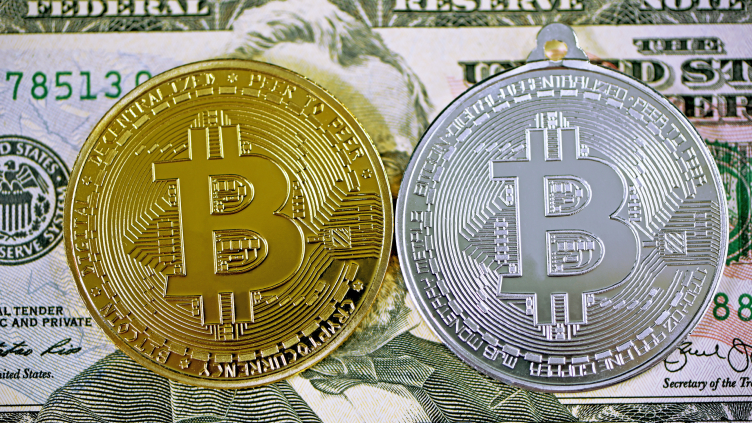
Germany Sells Final Bitcoin Reserves of Initial $3 Billion in Holdings
The German government completed the sale of its remaining Bitcoin holdings on July 12. The final transaction involved 3,846 Bitcoin, valued at around $62,604 per Bitcoin, which were sent to “Flow Traders and 139Po,” entities likely for institutional/OTC deposit services, according to for Arkham Intelligence.
The majority of the 50,000 Bitcoins sold by the German government over the past three weeks originated from asset seizures. This sale marked the culmination of weeks of increased sales activity by the German government, which unloaded tens of thousands of Bitcoins in multiple tranches. This significant liquidation was a key factor in keeping the Bitcoin selloff at a low of $54,000 on July 5.
Despite Germany’s exit from its Bitcoin holdings, market pressures remain due to Mt. Gox’s impending $9 billion repayment plan. The Mt. Gox exchange, which collapsed in 2014 when Bitcoin was still in the hundreds of dollars, has long been a source of market anxiety. The repayment plan aims to compensate creditors, potentially adding significant selling pressure to the market in the coming weeks. However, it is difficult to estimate the impact of Mt. Gox’s repayment on the markets due to several factors.
Amid heightened selling pressure, institutional investors seized the opportunity to buy the dip. Data from CoinShares showed that U.S. exchange-traded funds (ETFs) saw $295 million in inflows during the week of July 8, reversing a trend of suppressed inflows into these investment funds. This activity suggests that institutional investors remain confident in Bitcoin’s long-term prospects.
Bitcoin
Bitcoin surges as traders bet on Donald Trump election victory after shooting

Unlock the US Election Countdown newsletter for free
The stories that matter about money and politics in the race for the White House
Bitcoin surged on Monday following an assassination attempt on Donald Trump, as investors increased their bets on the former president winning the US presidential election in November.
Bitcoin’s price rose as much as 9.1 percent to $62,830, its highest level in two weeks, after a shooter hit Trump in the ear at a campaign rally over the weekend. The Republican is seen as the most pro-crypto candidate, having hosted industry executives at Mar-a-Lago and expressed enthusiasm for bitcoin mining in the U.S.
Trump’s campaign also accepted cryptocurrency payments, a first for a major U.S. political party, raising hopes of an end to the U.S. regulatory crackdown on the sector seen in recent years.
“The probability of a Donald Trump victory has increased significantly,” said Grzegorz Dróżdż, market analyst at exchange firm Conotoxia, adding that a Trump presidency would have a “positive impact” on cryptocurrencies.
Shares of Trump’s Truth social media company jumped 60 percent in premarket trading. Trump Media & Technology Group went public in March in a merger with a blank-check company and rallied ahead of the debate between Trump and President Joe Biden last month.
The slimmer chances of a second Trump presidency were also felt in broader financial markets. U.S. Treasury yields and the dollar rose in a more muted version of the reaction that followed Biden’s disastrous debate performance.
Many investors believe Trump’s tax-cutting policies would increase deficits and inflation, hurting U.S. Treasuries and boosting the dollar, in a pattern similar to what occurred after his 2016 election victory.
The U.S. dollar index, which tracks the greenback against a basket of six other major currencies, rose 0.2% in morning trade, having weakened so far in July as investors increased their bets on a September interest rate cut by the Federal Reserve.
Yields on benchmark 10-year Treasuries rose 0.03 percentage point to 4.21 percent, reflecting a small decline in price. Contracts tracking Wall Street’s blue-chip S&P 500 and the tech-heavy Nasdaq 100 rose 0.3 percent and 0.5 percent ahead of the New York open.
Monday’s movements “touch[s] with a Trumpian theme given the popular narrative that he is good for business and… his pro-crypto stance,” Rabobank analysts said in a note to clients.
“For markets, the complexities of the US political landscape have boiled down to the assumption that the weekend’s events will lead to a greater chance of Trump winning the November presidential election,” they added.
Bitcoin peaked above $70,000 in mid-March but has struggled to make headway since the so-called halving event in April, when the number of daily bitcoins available for miners to share to secure the bitcoin network fell from 900 to 450. Some analysts had expected bitcoin to rebound after the halving.
-

 News1 year ago
News1 year ago“Captain Tsubasa – RIVALS” launches on Oasys Blockchain
-

 Ethereum1 year ago
Ethereum1 year agoComment deux frères auraient dérobé 25 millions de dollars lors d’un braquage d’Ethereum de 12 secondes • The Register
-

 News1 year ago
News1 year agoSolana ranks the fastest blockchain in the world, surpassing Ethereum, Polygon ⋆ ZyCrypto
-

 Videos1 year ago
Videos1 year agoIs Emorya the next gem💎 of this Bitcoin bull run?
-

 Videos1 year ago
Videos1 year agoHistoric steps for US cryptocurrencies! With a shocking majority vote!🚨
-

 News1 year ago
News1 year agoSolana Surpasses Ethereum and Polygon as the Fastest Blockchain ⋆ ZyCrypto
-

 Videos1 year ago
Videos1 year agoNexus Chain – Ethereum L2 with the GREATEST Potential?
-

 Ethereum1 year ago
Ethereum1 year agoScaling Ethereum with L2s damaged its Tokenomics. Is it possible to repair it?
-

 News1 year ago
News1 year agoFnality, HQLAᵡ aims to launch blockchain intraday repositories this year – Ledger Insights
-

 Regulation1 year ago
Regulation1 year agoFinancial Intelligence Unit imposes ₹18.82 crore fine on cryptocurrency exchange Binance for violating anti-money laundering norms
-

 Bitcoin1 year ago
Bitcoin1 year agoBitcoin Drops to $60K, Threatening to Derail Prices of Ether, Solana, XRP, Dogecoin, and Shiba Inu ⋆ ZyCrypto
-

 News1 year ago
News1 year agoSendBlocks Debuts with Major Support to Improve Blockchain Data Management

